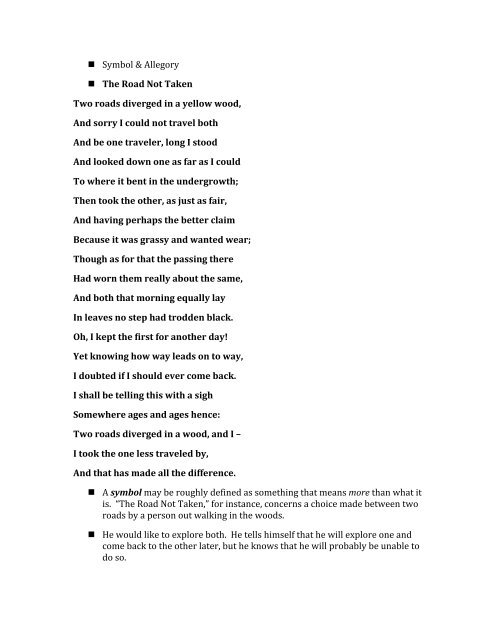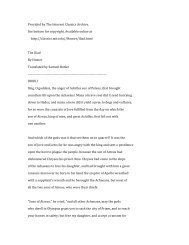Symbol & Allegory The Road Not Taken Two roads diverged in a yello
Symbol & Allegory The Road Not Taken Two roads diverged in a yello
Symbol & Allegory The Road Not Taken Two roads diverged in a yello
Create successful ePaper yourself
Turn your PDF publications into a flip-book with our unique Google optimized e-Paper software.
n <strong>Symbol</strong> & <strong>Allegory</strong><br />
n <strong>The</strong> <strong>Road</strong> <strong>Not</strong> <strong>Taken</strong><br />
<strong>Two</strong> <strong>roads</strong> <strong>diverged</strong> <strong>in</strong> a <strong>yello</strong>w wood,<br />
And sorry I could not travel both<br />
And be one traveler, long I stood<br />
And looked down one as far as I could<br />
To where it bent <strong>in</strong> the undergrowth;<br />
<strong>The</strong>n took the other, as just as fair,<br />
And hav<strong>in</strong>g perhaps the better claim<br />
Because it was grassy and wanted wear;<br />
Though as for that the pass<strong>in</strong>g there<br />
Had worn them really about the same,<br />
And both that morn<strong>in</strong>g equally lay<br />
In leaves no step had trodden black.<br />
Oh, I kept the first for another day!<br />
Yet know<strong>in</strong>g how way leads on to way,<br />
I doubted if I should ever come back.<br />
I shall be tell<strong>in</strong>g this with a sigh<br />
Somewhere ages and ages hence:<br />
<strong>Two</strong> <strong>roads</strong> <strong>diverged</strong> <strong>in</strong> a wood, and I –<br />
I took the one less traveled by,<br />
And that has made all the difference.<br />
n A symbol may be roughly def<strong>in</strong>ed as someth<strong>in</strong>g that means more than what it<br />
is. “<strong>The</strong> <strong>Road</strong> <strong>Not</strong> <strong>Taken</strong>,” for <strong>in</strong>stance, concerns a choice made between two<br />
<strong>roads</strong> by a person out walk<strong>in</strong>g <strong>in</strong> the woods.<br />
n He would like to explore both. He tells himself that he will explore one and<br />
come back to the other later, but he knows that he will probably be unable to<br />
do so.
n By the last stanza, however, we realize that the poem is about someth<strong>in</strong>g<br />
more than the choice of paths <strong>in</strong> a wood, for that choice would be relatively<br />
unimportant.<br />
n This poem is about a critical life-‐alter<strong>in</strong>g choice.<br />
n Why a road?<br />
n We must <strong>in</strong>terpret the poet’s choice of a road as a symbol for any choice <strong>in</strong><br />
life between alternatives that appear almost equally attractive but will result<br />
through the years <strong>in</strong> a large difference <strong>in</strong> the k<strong>in</strong>d of experience one knows.<br />
n Image, metaphor, and symbol shade <strong>in</strong>to each other and are sometimes<br />
difficult to dist<strong>in</strong>guish.<br />
n Here’s an easy-‐to-‐follow breakdown:<br />
n In general, an image means only what it is.<br />
n <strong>The</strong> figurative term <strong>in</strong> a metaphor means someth<strong>in</strong>g other than what it is.<br />
n And a symbol means what it is and someth<strong>in</strong>g more, too.<br />
n A symbol functions literally and figuratively at the same time.<br />
n If I say that a shaggy brown dog was rubb<strong>in</strong>g its back aga<strong>in</strong>st a white picket<br />
fence, I am talk<strong>in</strong>g about noth<strong>in</strong>g more than a dog (and a picket fence) and<br />
am therefore present<strong>in</strong>g an image.<br />
n If I say, “Some dirty dog stole my wallet at the party,” I am not talk<strong>in</strong>g about a<br />
dog at all and am therefore us<strong>in</strong>g a metaphor.<br />
n BUT if I say, “You can’t teach an old dog new tricks,” I am talk<strong>in</strong>g not only<br />
about dogs but about liv<strong>in</strong>g creatures of any species and am therefore<br />
speak<strong>in</strong>g symbolically.<br />
n Images do not cease to be images when they become <strong>in</strong>corporated <strong>in</strong><br />
metaphors or symbols. We simply use the term most relevant to the aspect<br />
of the poem we are discuss<strong>in</strong>g.<br />
n If we’re discuss<strong>in</strong>g the sensuous qualities of “<strong>The</strong> <strong>Road</strong> <strong>Not</strong> <strong>Taken</strong>,” we would<br />
refer to the two leaf-‐strewn <strong>roads</strong> as an image.<br />
n If we are discuss<strong>in</strong>g the significance of the poem, we will talk about the <strong>roads</strong><br />
as symbols.<br />
n <strong>The</strong> symbol is usually so general <strong>in</strong> its mean<strong>in</strong>g that it can suggest a great<br />
variety of specific mean<strong>in</strong>gs.
n “<strong>The</strong> <strong>Road</strong> <strong>Not</strong> <strong>Taken</strong>” concerns a choice <strong>in</strong> life, but what choice? Was it a<br />
choice of profession? A choice of residence? A choice of mate? It could be all<br />
or none…<br />
n We cannot def<strong>in</strong>itively answer this question, and it is not important that we<br />
do so.<br />
n It is enough if we see <strong>in</strong> the poem an expression of regret that the<br />
possibilities of life experience are so sharply limited.<br />
n Because the symbol is a rich one, other mean<strong>in</strong>gs are also suggested.<br />
n It affirms a belief <strong>in</strong> the possibility of choice (as opposed to fate) and says<br />
someth<strong>in</strong>g about the nature of choice – how each choice narrows the range of<br />
possible future choices, so that we make our lives as we go, both freely<br />
choos<strong>in</strong>g and be<strong>in</strong>g determ<strong>in</strong>ed by past choices.<br />
n Though not a philosophical poem, it comments on the issue of free will and<br />
<strong>in</strong>dicates the poet’s own position. It can do all these th<strong>in</strong>gs, concretely and<br />
compactly, by its use of an effective symbol.<br />
n Consider the follow<strong>in</strong>g poem…<br />
n <strong>The</strong> Sick Rose<br />
Rose, thou art sick!<br />
<strong>The</strong> <strong>in</strong>visible worm<br />
That flies <strong>in</strong> the night,<br />
In the howl<strong>in</strong>g storm,<br />
Has found out thy bed<br />
Of crimson joy<br />
And his dark secret love<br />
Does thy life destroy<br />
William Blake (1757-‐1827)<br />
1. What figures of speech do you f<strong>in</strong>d <strong>in</strong> the poem <strong>in</strong> addition to symbol? How<br />
do they contribute to its force or mean<strong>in</strong>g?<br />
2. Can you th<strong>in</strong>k of and expla<strong>in</strong> a symbolic <strong>in</strong>terpretation of the poem?<br />
n <strong>The</strong> rose, apostrophized and personified <strong>in</strong> the first l<strong>in</strong>e, has traditionally<br />
been a symbol fem<strong>in</strong><strong>in</strong>e beauty and love, as well as of sensual pleasures.
n “Bed” can refer to woman’s bed as well as to a flower bed.<br />
n “Crimson joy” suggests the pleasure of passionate lovemak<strong>in</strong>g, as well as the<br />
brilliant beauty of a red flower.<br />
n <strong>The</strong> “dark secret of love” of the “<strong>in</strong>visible worm” is more strongly suggestive<br />
of a concealed or illicit love affair than of the feed<strong>in</strong>g of a cankerworm on a<br />
plant, though it fits that too.<br />
n For all these reasons, the rose almost immediately suggests a woman and the<br />
worm her secret lover – and the poem suggests the corruption of <strong>in</strong>nocent<br />
but physical love by concealment and deceit.<br />
n <strong>The</strong> worm is a common symbol or metonymy for death, and fans of Jon<br />
Milton (like Blake) would recall the “undy<strong>in</strong>g worm” of Paradise Lost,<br />
Milton’s metaphor for the snake that tempted Eve.<br />
n Are other <strong>in</strong>terpretations possible?<br />
n Yes.<br />
n “<strong>The</strong> Sick Rose” has been <strong>in</strong>terpreted as referr<strong>in</strong>g to the destruction of love<br />
by jealousy, deceit, or the possessive <strong>in</strong>st<strong>in</strong>ct; of <strong>in</strong>nocence by experience; of<br />
imag<strong>in</strong>ation and joy by analytic reason; of life by death.<br />
n We cannot say for sure what the poet had <strong>in</strong> m<strong>in</strong>d, nor do we need to.<br />
n A symbol def<strong>in</strong>es an area of mean<strong>in</strong>g, and any <strong>in</strong>terpretation that falls with<strong>in</strong><br />
that area is permissible.<br />
n In Blake’s poem, the rose stands for someth<strong>in</strong>g beautiful, or desirable, or<br />
good.<br />
n <strong>The</strong> worm stands for some corrupt<strong>in</strong>g agent.<br />
n With<strong>in</strong> these limits, the mean<strong>in</strong>g is largely “open.”<br />
n For <strong>in</strong>stance, the poem may rem<strong>in</strong>d some of a gifted friend whose promise<br />
and potential have been destroyed by drug addiction.<br />
n Digg<strong>in</strong>g<br />
Between my f<strong>in</strong>ger and my thumb<br />
<strong>The</strong> squat pen rests; snug as a gun.<br />
Under my w<strong>in</strong>dow, a clean rasp<strong>in</strong>g sound<br />
When the spade s<strong>in</strong>ks <strong>in</strong>to gravelly ground:<br />
My father, digg<strong>in</strong>g. I look down
Till his stra<strong>in</strong><strong>in</strong>g rump among the flowerbeds<br />
Bends low, comes up twenty years away<br />
Stoop<strong>in</strong>g <strong>in</strong> rhythm through potato drills<br />
Where he was digg<strong>in</strong>g.<br />
<strong>The</strong> coarse boot nestled on the lug, the shaft<br />
Aga<strong>in</strong>st the <strong>in</strong>side knee was levered firmly.<br />
He rooted out tall tops, buried the bright edge deep<br />
To scatter new potatoes that we picked<br />
Lov<strong>in</strong>g their cool hardness <strong>in</strong> our hands.<br />
By God, the old man could handle a spade.<br />
Just like his old man<br />
My grandfather cut more turf <strong>in</strong> a day<br />
Than any other man on Toner’s bog.<br />
Once I carried him milk <strong>in</strong> a bottle<br />
Corked sloppily with paper. He straightened up<br />
To dr<strong>in</strong>k it, then fell to right away<br />
Nick<strong>in</strong>g and slic<strong>in</strong>g neatly, heav<strong>in</strong>g sods<br />
Over his shoulder, go<strong>in</strong>g down and down<br />
For the good turf. Digg<strong>in</strong>g<br />
<strong>The</strong> cold smell of potato mould, the squelch and slap<br />
Of soggy peat, the curt cuts of an edge<br />
Through liv<strong>in</strong>g roots awaken <strong>in</strong> my head.<br />
But I’ve no spade to follow men like them.<br />
Between my f<strong>in</strong>ger and my thumb<br />
<strong>The</strong> squat pen rests.<br />
I’ll dig with it.<br />
Seamus Heaney (b. 1939)
What emotional responses are evoked by the imagery?<br />
On the literal level, what does this poem present?<br />
-‐a writer who <strong>in</strong>terrupts himself to have a look at his<br />
digg<strong>in</strong>g <strong>in</strong> a flower garden below his w<strong>in</strong>dow. He is<br />
rem<strong>in</strong>ded of his father twenty years earlier, and by that<br />
memory is drawn farther back to his grandfather<br />
digg<strong>in</strong>g peat from a bog for fuel.<br />
n What clues us <strong>in</strong> to the idea that there is more go<strong>in</strong>g on than meets the eye?<br />
n <strong>The</strong> title and the emphasis on varieties of the same task carried out <strong>in</strong> several<br />
different ways over a span of generations alert the reader to the need to<br />
discover the further significance of this literal statement.<br />
n <strong>The</strong> last l<strong>in</strong>e is metaphorical, compar<strong>in</strong>g digg<strong>in</strong>g to writ<strong>in</strong>g.<br />
n Is it also symbolic?<br />
n No, because on a literal level, one cannot dig with a pen.<br />
n <strong>The</strong> symbolism comes from the act of digg<strong>in</strong>g itself.<br />
n Digg<strong>in</strong>g has mean<strong>in</strong>gs that relate to basic needs – for warmth, for<br />
sustenance, for beauty, and for the personal satisfaction of do<strong>in</strong>g a job<br />
well.<br />
n In the conclud<strong>in</strong>g metaphor, one basic need is implied, the need to remember<br />
and confront one’s orig<strong>in</strong>s, to f<strong>in</strong>d oneself <strong>in</strong> a cont<strong>in</strong>uum of mean<strong>in</strong>gful<br />
activities, to assert the relevance and importance of one’s vocation.<br />
n Mean<strong>in</strong>gs ray out from a symbol, like the corona around the sun or like<br />
connotations around a richly suggestive word.<br />
n However, we must use tact and careful judgment when <strong>in</strong>terpret<strong>in</strong>g symbols.<br />
n Although Blake’s “<strong>The</strong> Sick Rose” might rem<strong>in</strong>d us of drug addiction, it would<br />
be unwise to say that Blake uses the rose to symbolize this.<br />
n This <strong>in</strong>terpretation is private and narrow. <strong>The</strong> poem allows it, but does not<br />
itself suggest it.<br />
n Just because a symbol is “open,” we cannot make it say anyth<strong>in</strong>g we choose.<br />
We have to stay with<strong>in</strong> the range of the text.
n To <strong>in</strong>terpret “<strong>The</strong> <strong>Road</strong> <strong>Not</strong> <strong>Taken</strong>” as a choice between good and evil is to<br />
impose mean<strong>in</strong>g that is simply not there.<br />
n <strong>The</strong> poem tells us that the <strong>roads</strong> are much alike and lie “<strong>in</strong> leaves no step had<br />
trodden black.”<br />
n Whatever the choice may be, it is one between two goods.<br />
n <strong>The</strong> reader who reads <strong>in</strong>to such a poem anyth<strong>in</strong>g imag<strong>in</strong>able might as well<br />
discard the poem and simply daydream.<br />
n Avoid symbol-‐hunt<strong>in</strong>g. It is better to miss a symbol or two than to attempt to<br />
f<strong>in</strong>d one <strong>in</strong> every l<strong>in</strong>e of a poem.<br />
n Lastly, an allegory is a narrative or description that has a second mean<strong>in</strong>g<br />
beneath the surface.<br />
n Although the surface story or description may have its own <strong>in</strong>terest, the<br />
author’s major <strong>in</strong>terest is <strong>in</strong> the ulterior mean<strong>in</strong>g.<br />
n Examples of allegories:<br />
n Lord of the Flies<br />
n Animal Farm<br />
n <strong>The</strong> Matrix<br />
n V for Vendetta<br />
n Avatar





